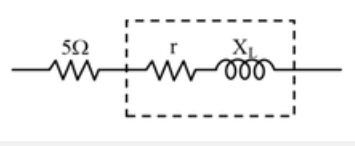Assertion: The alternating current lags behined the e.m.f. by a phase angle of π/2, when AC flows through an inductor.
Reason: The inductive reactance increases as the frequency of AC source decreases.
a.If both assertion and reason are ture and reason is the correct explanation of assertion
b.If both assertion and reason are true but reason is not the correct explanation of assertion
c.If assertion is true but reason is false
d.If both assertion and reson are false.
The correct Answer is:C
To solve the question, we need to analyze both the assertion and the reason provided.
Step 1: Analyze the Assertion
The assertion states that "The alternating current lags behind the e.m.f. by a phase angle of π/2 when AC flows through an inductor."
- In an inductor, the voltage across the inductor (V_L) leads the current (I) by a phase angle of π/2. This means that the current lags behind the voltage by π/2.
- Mathematically, if we express the current as I=I0sin(ωt), then the voltage across the inductor can be expressed as:
VL=LdIdt=LI0ωcos(ωt)=LI0ωsin(ωt+π2)
- From this, we can see that the current lags the voltage by π/2. Therefore, the assertion is True.
Step 2: Analyze the Reason
The reason states that "The inductive reactance increases as the frequency of the AC source decreases."
- Inductive reactance (X_L) is given by the formula:
XL=ωL=2πfL
where ω is the angular frequency and f is the frequency of the AC source.
- From this formula, we can see that as the frequency (f) decreases, the inductive reactance (X_L) also decreases. Therefore, the reason is False.
Conclusion
- The assertion is True, and the reason is False. Therefore, the correct answer is option C: Assertion is true but reason is false.
The assertion states that "The alternating current lags behind the e.m.f. by a phase angle of π/2 when AC flows through an inductor."
- Mathematically, if we express the current as I=I0sin(ωt), then the voltage across the inductor can be expressed as:
VL=LdIdt=LI0ωcos(ωt)=LI0ωsin(ωt+π2)
- From this, we can see that the current lags the voltage by π/2. Therefore, the assertion is True.
The reason states that "The inductive reactance increases as the frequency of the AC source decreases."
XL=ωL=2πfL
where ω is the angular frequency and f is the frequency of the AC source.
- From this formula, we can see that as the frequency (f) decreases, the inductive reactance (X_L) also decreases. Therefore, the reason is False.
- The assertion is True, and the reason is False. Therefore, the correct answer is option C: Assertion is true but reason is false.
Similar Questions
A variable inductor inductor is connected to an AC source. When inductance increases, The reactance
View SolutionAn alternating emf of 110 V is applied to a circuit containing a resistance R of 80Ω and an inductor L in series. The current is found to lag behind the supply voltage by an angle θ=tan1(3/4). Find the :
If the inductor has a coefficient of self inductance of 0.1 H, what is the frequency of the applied emf ?
View SolutionThe current through an inductor of impedance 10Ω lags behind the voltage by a phase of 60∘ when just the inductor is connected to the ac source. Now the inductor is connected to a 5Ω resistance in series, then the net impedance of the circuit is

View SolutionProve that the current flowing through an ideal inductor connected across a.c. source, lags the voltage in phase by π2.
View SolutionAn alternating emf of 110 V is applied to a circuit containing a resistance R of 80Ω and an inductor L in series. The current is found to lag behind the supply voltage by an angle θ=tan−1(3/4). Find the :
(i) Inductive reactance
(ii) Impedance of the circuit
(iii) Current flowing in the circuit
(iv) If the inductor has a coefficient of self inductance of 0.1 H. What is the frequency of the applied emf?
View SolutionA resistor R an inductance L and a capacitor C are all connected in series with an ac supply The resistance of R is 16ohm and for the given frequency the inductive reactance of L is 24 ohm and the capacitive reactance of C is 12ohm If the current in the circuit is 5A find
(a) the potential difference across R,L and C
(b) the impedance of the circuit
(c) the voltage of the ac supply and
(d) the phase angle .
View SolutionThe frequency of oscillation of current in the indcutor is

View SolutionAssertion : In an L−R series circuit in AC, current in the circuit will decrease with increase in frequency.
Reason : Phase difference between current function and voltage function will increase with increase in frequency.
View SolutionAssertion: When a ferromagnetic rod is inserted inside an inductor, then current in L-C-R, alternating circuit will decrease.
Reason: By inserting the ferromagnetic rod inside the inductor, coefficient of self induction and hence the net impedance will increases.
View SolutionThe current through two inductors of self inductance 12 mH and 30 mH is increasing with time at the same rate. Draw graphs showing the variation of the (a ) e.m.f. induced with the rate of change of current in each inductor. (b) enargy stored in each inductor with the current flowing through it.
Compare the energy stored in the coils if power dissipated in the coil is same.
View Solution
